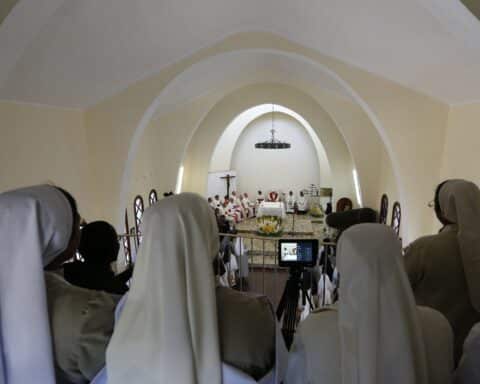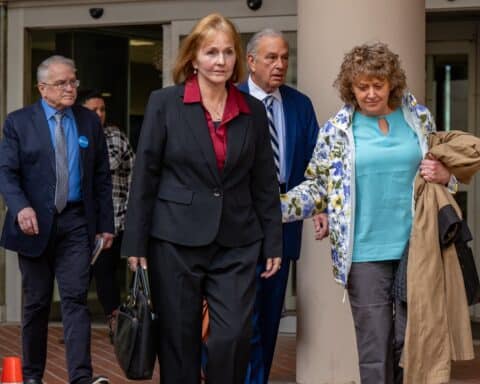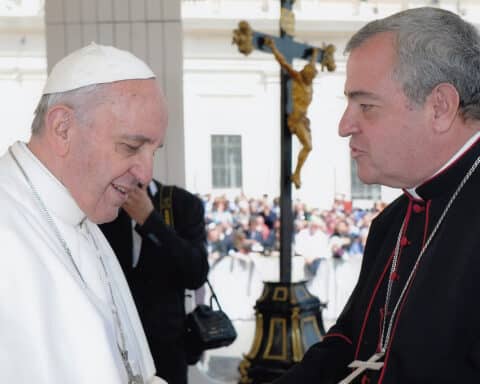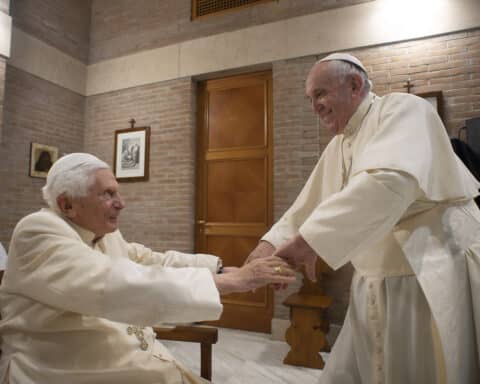Pope Emeritus Benedict XVI has written a lengthy letter in response to the current crisis engulfing the Church. It comes in response to the recent summit on abuse hosted in Rome by Pope Francis Feb. 21-24, which called together the presidents of the world’s episcopal conferences.
The letter is the result of Benedict’s desire to “contribute to a new beginning” for the Church and help “make the Church again truly credible.”
It’s apparent its publication was a matter of conscience for Benedict, given his past roles of governance when the scandal first broke: He served as prefect for the Congregation for the Doctrine of the Faith from 1981 until his 2005 election as pope — an office that he then occupied for nearly eight years.
The letter is the lengthiest public statement to date from Pope Benedict since his 2013 resignation. The prefatory note makes clear this letter was published with the knowledge of Pope Francis and Cardinal Pietro Parolin, the Vatican secretary of state.
Composed of three main sections, the letter surveys the collapse of normative standards of sexuality beginning in the 1960s and how that affected formation and lives of priests, and it intends to contribute to a “proper response on the part of the Church.”
Sexual revolution
Since the Church’s current crisis is centered on sexual abuse by clergy, Benedict provides a backdrop for the predatory and deviant sexual behavior among clergy. He situates the crisis in “the wider social context” of the “all-out sexual freedom” won in 1968 that “no longer conceded any norms” — even terminating in violence and the acceptance of pedophilia, which he notes was “then also diagnosed as allowed and appropriate.”
Benedict noted these years were especially difficult on the Church’s young people, and he long has wondered how priesthood could be accepted “with all its ramifications” by members of that generation. The result, he says, was the “extensive collapse of the next generation of priests in those years.”
Alongside this sexual revolution, Benedict says that “Catholic moral theology suffered a collapse that rendered the Church defenseless against these changes in society,” which had an effect “on the diverse areas of the Church.” Among those areas, given the attention to the topic at the recent sex abuse summit in Rome, he draws attention to seminaries and priestly formation.
Benedict acknowledges the existence of “homosexual cliques” in seminaries. Given his citation of the two American apostolic visitation of seminaries, he indicates the problem may have been notable in the United States. He said the first (ordered in 1981) “brought no new insights” and the second “failed to achieve any outcomes.” While he cites the culture of seminaries “generally improved” after the 1970s, he indicates “only isolated cases of a new strengthening of priestly vocations came about.”
To protect the Faith
Writing on the abuse crisis, Benedict does not mention the phrase “zero tolerance,” popularized since the U.S. bishops’ 2002 Charter for the Protection of Children and Young People. But he explains the importance and necessity of it, and he outlines some of the problems with effectively punishing abusive clerics. These existed in a “deliberately loosely constructed criminal law of the new Code” of Canon Law (promulgated in 1983) and a default “procedural protectionism” of the rights of the accused, which he calls “guarantorism.” Although he does not say so explicitly, this system suggests a clericalist culture that, intentionally or not, obstructed true justice.
Benedict explains how protecting the rights of those accused must be held alongside a protection of the Faith. He says that this is what Jesus primarily means in Mark 9:42 when he says, “Whoever causes one of these little ones who believe [in me] to sin, it would be better for him if a great millstone were put around his neck and he were thrown into the sea.”
“The phrase ‘the little ones’ in the language of Jesus means the common believers who can be confounded in their faith by the intellectual arrogance of those who think they are clever,” Benedict writes, “So here Jesus protects the deposit of the Faith with an emphatic threat of punishment to those who do it harm.”
For this reason, Benedict says his predecessor Pope St. John Paul II assigned that responsibility for cases of sexual abuse of minors to the Congregation for the Doctrine of the Faith. And that is what ultimately made it possible for convicted abusers to be permanently removed from ministry and even removed from the clerical state.
Despite this, Benedict indicates such principles have not taken root. “One generally falls on deaf ears when it comes to the question of the protection of the Faith as a legal good,” he writes, “… the Faith no longer appears to have the rank of a good requiring protection. This is an alarming situation which must be considered and taken seriously by the pastors of the Church.”
Within Benedict’s treatment of the collapse of Catholic moral theology, one cannot help but recognize how this breakdown also contributed to the pervasive cover-ups of sexual abuse by clergy, and the silence of many clergy regarding known and sometimes even promoted abusers — as seen in the Theodore McCarrick case.
In the face of untruths and obfuscations by many manifested since the sexual abuse crisis became public — all of which bring untold damage to the Faith and its credibility — Benedict presents the better way: “There are values which must never be abandoned for a greater value and even surpass the preservation of physical life. There is martyrdom.”
Moving forward
Benedict begins the conclusion of his letter with a beautiful summation of the Church’s faith in a God who is love, and the difficulties that are created in a society without God. When there is no God, Benedict says, there is no meaning to the world.
“Then there are no standards of good or evil,” he writes. “Then only what is stronger than the other can assert itself. Power is then the only principle. Truth does not count, it actually does not exist.”
It is within such a world that Benedict explains perverted sexual practices, particular paedophilia, can flourish. He suggests the Church move forward by identifying the truth while holding on to hope. “It is very important to oppose the lies and half-truths of the devil with the whole truth: Yes, there is sin in the Church and evil. But even today there is the Holy Church, which is indestructible.” Instead of “becoming masters of faith,” Benedict proposes we should be “renewed and mastered by the Faith.” He explains this exists when the Eucharist is truly central in the life of each Christian.
While Benedict does not propose any reforms to ecclesial structure (nor does he warn against any such attempts), he gives the road map for true reform, nonetheless. Simply, yet radically, he says, “What is required first and foremost is the renewal of the Faith in the reality of Jesus Christ given to us in the Blessed Sacrament.”
For signs of hope, we must turn to those who live their lives accordingly, who are found “especially among ordinary people, but also in the high ranks of the Church,” Benedict says.
“Today there are many people who humbly believe, suffer and love, in whom the real God, the loving God, shows himself to us. Today God also has his witnesses (martyres) in the world. We just have to be vigilant in order to see and hear them.”
Michael R. Heinlein is editor of OSV’s Simply Catholic. He writes from Indiana.





